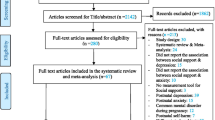Abstract
Self-efficacy is an important indicator of a woman’s successful transition to her maternal role and an important predictor of a mother’s infant care behavior. This study aimed to evaluate the validity of the maternal self-efficacy scale in Iranian mothers. This cross-sectional study was conducted on 437 newly delivered mothers who were referred to health care centers in Bonab, Iran. A simple random sampling was performed. The research instrument included maternal self-efficacy. Translation validity was performed using the forward and backward translation method. Content validity was determined in qualitative (assessment of experts’ opinions) and quantitative areas using the content validity ratio (CVR) and Content Validity Index (CVI). Face validity was determined on 30 newly delivered mothers. To determine the construct validity, exploratory factor analysis was used. The reliability was determined in terms of reproducibility via Intra-class correlation coefficient (ICC) by test–retest and internal consistency (Cronbach’s alpha). CVI and CVR were 0.91 and 0.94 respectively. Further, the reliability was approved both in terms of reproducibility (ICC = 0.98) and internal consistency (α = 0.89). Construct validity was confirmed using exploratory factor analysis (KMO = 0.90, Bartlett’s test p < 0.001) for the scale. The findings supported the validity and reliability of the research instrument. Therefore, it is recommended that the instrument can be used in both clinical practice and research.
Similar content being viewed by others
References
Anzman-Frasca, S., Stifter, C. A., Paul, I. M., & Birch, L. L. (2013). Infant temperament and maternal parenting self-efficacy predict child weight outcomes. Infant Behavior & Development, 36(4), 494–497. doi:10.1016/j.infbeh.2013.04.006.
Bandura, Albert. (1982). Self-efficacy mechanism in human agency. American Psychologist, 37(2), 122.
Dianat, I., Ghanbari, Z., & AsghariJafarabadi, M. (2014). Psychometric properties of the persian language version of the system usability scale. Health Promotion Perspectives, 4(1), 82–89. doi:10.5681/hpp.2014.011.
Duprez, V., Van Hooft, S. M., Dwarswaard, J., van Staa, A., Van Hecke, A., & Strating, M. M. (2016). The development and psychometric validation of the self-efficacy and performance in self-management support (SEPSS) Instrument. Journal of Advanced Nursing, 72(6), 1381–1395. doi:10.1111/jan.12918.
Eaton, M. M. (2007). Self-efficacy in first-time mothers. (3298004), (ProQuest Dissertations & Theses Global database, Kansas State University, Ann Arbor).
Karran, J. C., Moodie, E. E., & Wallace, M. P. (2015). Statistical method use in public health research. Scandinavian Journal of Public Health, 43(7), 776–782. doi:10.1177/1403494815592735.
Khorramirad, A., Lotfi, M. M., & Bidgoli, A Sh. (2010). Prevalence of postpartum depression and related factors in Qom. Pajoohandeh Journal, 15(2), 62–66.
Kobayashi, K. (2011). Letter to the editor: statistical tools used to analyse quantitative data. Journal of Toxicological Sciences, 36(3), 393–394.
Kohlhoff, J., & Barnett, B. (2013). Parenting self-efficacy: links with maternal depression, infant behaviour and adult attachment. Early Human Development, 89(4), 249–256. doi:10.1016/j.earlhumdev.2013.01.008.
Kreif, N., Grieve, R., & Sadique, M. Z. (2013). Statistical methods for cost-effectiveness analyses that use observational data: a critical appraisal tool and review of current practice. Health Economics, 22(4), 486–500. doi:10.1002/hec.2806.
Mortazavi, F., Mousavi, S. A., Chaman, R., & Khosravi, A. (2014). Maternal quality of life during the transition to motherhood. Iranian Red Crescent Medical Journal, 16(5), e8443. doi:10.5812/ircmj.8443.
Scult, M., Haime, V., Jacquart, J., Takahashi, J., Moscowitz, B., Webster, A., & Mehta, D. H. (2015). A healthy aging program for older adults: effects on self-efficacy and morale. Advances in Mind Body Medicine, 29(1), 26–33.
Shorey, S., Chan, S. W., Chong, Y. S., & He, H. G. (2015). Predictors of Maternal Parental Self-Efficacy Among Primiparas in the Early Postnatal Period. Western Journal of Nursing Research, 37(12), 1604–1622. doi:10.1177/0193945914537724.
Teti, D. M., & Gelfand, D. M. (1991). Behavioral competence among mothers of infants in the first year: the mediational role of maternal self-efficacy. Child Development, 62(5), 918–929.
Acknowledgments
This study was approved and financed by Tabriz University of Medical Sciences. We are very thankful to the health deputy of the university, all employees of healthcare centers in Bonab and all mothers who participated in this study.
Author information
Authors and Affiliations
Corresponding author
Rights and permissions
About this article
Cite this article
Mirghafourvand, M., Mohammad-Alizadeh-Charandabi, S., Asghari Jafarabadi, M. et al. Psychometric Properties of Maternal Self-Efficacy Questionnaire in a Population of Iranian Mothers. J Child Fam Stud 25, 2966–2971 (2016). https://doi.org/10.1007/s10826-016-0470-1
Published:
Issue Date:
DOI: https://doi.org/10.1007/s10826-016-0470-1




